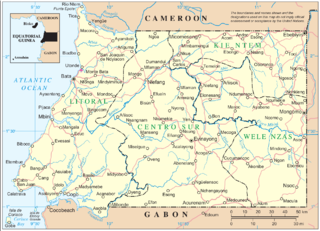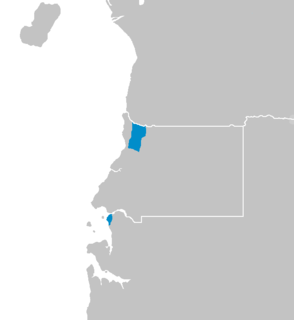Related Research Articles

Equatorial Guinea, officially the Republic of Equatorial Guinea, is a country on the west coast of Central Africa, with an area of 28,000 square kilometres (11,000 sq mi). Formerly the colony of Spanish Guinea, its post-independence name evokes its location near both the Equator and the Gulf of Guinea. As of 2021, the country had a population of 1,468,777.

The History of Equatorial Guinea is marked by centuries of colonial domination by the Portuguese, British and Spanish colonial empires, and by the local kingdoms.

The Republic of Equatorial Guinea is located in west central Africa. Bioko Island lies about 40 kilometers (24.9 mi) from Cameroon. Annobón Island lies about 595 kilometres (370 mi) southwest of Bioko Island. The larger continental region of Río Muni lies between Cameroon and Gabon on the mainland; it includes the islands of Corisco, Elobey Grande, Elobey Chico, and adjacent islets. The total land area is 28,051 km2 (10,831 sq mi). It has an Exclusive Economic Zone of 303,509 km2 (117,185 sq mi).

Malabo is the capital of Equatorial Guinea and the province of Bioko Norte. It is located on the north coast of the island of Bioko,. In 2018, the city had a population of approximately 297,000 inhabitants.

Río Muni is the Continental Region of Equatorial Guinea, and comprises the mainland geographical region, covering 26,017 square kilometres (10,045 sq mi). The name is derived from the Muni River, along which the early Europeans had built the Muni River Settlements.

Spanish Guinea was a set of insular and continental territories controlled by Spain from 1778 in the Gulf of Guinea and on the Bight of Bonny, in Central Africa. It gained independence in 1968 as Equatorial Guinea.

The Equatorial Guinea national football team represents Equatorial Guinea in men's international football and is controlled by the Equatoguinean Football Federation, a member of the Confederation of African Football (CAF).
Colegio Nacional Enrique Nvó Okenve is a college in Equatorial Guinea. The college has two campuses, based in the cities of Bata (seat) and Malabo.

Bata is a port city in the Litoral province of Equatorial Guinea. With a 2005 estimated population of 173,046, it is the largest city in Equatorial Guinea. It lies on the Atlantic Ocean coast of Río Muni. Bata was formerly capital of Equatorial Guinea and is a transport hub and port, from which ferries sail to Malabo and Douala, while aircraft can land at Bata Airport. Bata is also known for its nightlife and market.
Equatoguinean Spanish is the variety of Spanish spoken in Equatorial Guinea. This is the only Spanish variety that holds national official status in Sub-Saharan Africa. It is regulated by the Equatoguinean Academy of the Spanish Language and is spoken by about 90% of the population, estimated at 1,170,308 for the year 2010, all of them second-language speakers.

There have been major strides with Education in Equatorial Guinea over the past ten years, although there is still room for improvement. Among sub-Saharan African countries, Equatorial Guinea has one of the highest literacy rates. According to The World Factbook - Central Intelligence Agency as of 2015, 95.3% of the population age 15 and over can read and write in Equatorial Guinea were respectively literate. Education in Equatorial Guinea is overseen by the Ministry of Education and Science (MEC). Split into four levels, preschool, primary, secondary, and higher education, the Equatorial Guinea's educational system only deems preschool and primary school mandatory. Education in Equatorial Guinea is free and compulsory until the age of 14. Although it has a high GNI per capita, which, as of 2018, was 18,170 international dollars, its educational outcomes fall behind those of the rest of West and Central Africa. In 1993, the gross primary enrollment rate was 149.7 percent, and the net primary enrollment rate was 83.4 percent. Late entry into the school system and high dropout rates are common, and girls are more likely than boys to drop out of school. As of 2015, the net enrollment rates for each education level are as follows: 42 percent for preschool, between 60 percent and 86 percent for primary school, and 43.6 percent for secondary school. UNESCO has cited several issues with the current educational system, including poor nutrition, low quality of teachers, and lack of adequate facilities.

Equatorial Guinea was the only Spanish colony in Sub-Saharan Africa. During its colonial history between 1778 and 1968, it developed a tradition of literature in Spanish, unique among the countries in Africa, that persists until the present day.
Lengue people, or Balengue, are an African ethnic group, members of the Bantu group, who are indigenous to Equatorial Guinea and Gabon. Their indigenous language is Lengue. Today Bengas inhabit the coast region of the country's mainland, between Bata and the Gabonese border. This ethnic group has become increasingly influence by Fang culture during the past couple of decades; but have maintained their linguistic identity. They are referred to as Ndowe or "Playeros", one of several peoples on the Rio Muni coast.
The Bujeba or Kwasio people are an African ethnic group, members of the Bantu group, who are indigenous to Equatorial Guinea. Their indigenous language is Bujeba. Today Bujebas inhabit Northern and Southern Bata, and South of Rio Benito. The ethnic group has decreased in number, as most have assimilated into the Fang ethnic group due to their strong influence in recent decades. They are referred to as Ndowe or "Playeros", one of several peoples on the Rio Muni coast.

Seki, also Baseke, Sheke or Sekiana, is a language indigenous to Equatorial Guinea and Gabon. It had been spoken in villages of Rio Campo and Northern Bata, along the coast, but its native speakers have begun abandoning the language for Spanish, Fang, and Kombe. Can be related to Kako spoken in the East region of Cameroon and some parts of the west of Central African Republic.

The 2015 Africa Cup of Nations, known as the Orange Africa Cup of Nations, Equatorial Guinea 2015 for sponsorship reasons, was the 30th staging of the Africa Cup of Nations, the international men's football championship of Africa. It was organized by the Confederation of African Football (CAF) and was held from 17 January to 8 February 2015.
Iyasa is a Bantu language spoken in Cameroon and Equatorial Guinea by the Iyasa and Ndowe coastal fishing peoples. It is also spoken by Pygmies, perhaps Babongo, in Gabon. Approximately 3,000 people speak Iyasa, though some note that this number may be an overestimation.

The Okuyi is a rite of passage practised by several Bantu ethnic groups in different countries mainly across the west coast of Central Africa. Some of the countries where the rite is exercised include Cameroon in West Central Africa, Gabon and Equatorial Guinea. Traditionally, the rite is performed at numerous special occasions including funerals and weddings. Usually when an infant reaches four months of age or when a child becomes an adolescent, an Okuyi ritual is applied as well. Today, the Mekuyo rite is exercised by a range of ethnic peoples within the Bantu cluster. The coastal community known as Ndowe, also known as playeros, is a primary example, as peoples across Equatorial Guinea frequently perform the ritual in public. Gabon has two chief ethnic groups that exercise the Okuyi rite including the Mpongwe and Galwa from Lambaréné, Gabon. The man in the custome is usually the leader of the group.
Regina Mañe Ela was an Equatorial Guinean politician and opposition campaigner.

The 1936 uprising in Spanish Guinea was an armed conflict over the control of Spanish Guinea during the course of the Spanish Civil War. Fought between the republican and nationalist forces between September and October 1936. The nationalists initially took control of Fernando Poo on 19 September, later seizing control of the rest of the colony after receiving reinforcements in October.
References
- ↑ Fiona MacDonald; Marshall Cavendish Corporation; Elizabeth Paren; Kevin Shillington; Gillian Stacey; Philip Steele (2000). Peoples of Africa, Volume 10. Marshall Cavendish. p. 153. ISBN 978-0-7614-7158-5.
- ↑ Nassau, Robert Hamill (1901). "Fetishism, a Government". Bulletin of the American Geographical Society. 33 (4): 305–317. doi:10.2307/198420. JSTOR 198420.
- ↑ "Equatorial Guinea History" (in Spanish). Guinea-Ecuatorial.info. Archived from the original on 14 September 2011. Retrieved 20 September 2011.